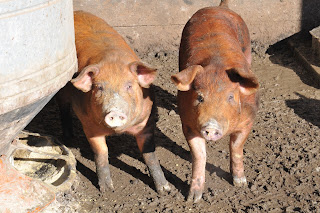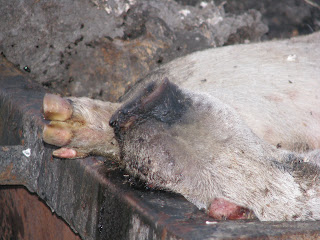Pop Quiz
Killer bacteria MRSA are:
A.) a horror in our food chain
B.) a hot new political issue
C.) hot for string bikinis
D.) NOT any kind of flu
X E.) all the above
If you haven’t already heard of MRSA (pronounced “mersa‘), consider yourself lucky. For five years, Methicillin-resistant Staphylococcus aureus has been infecting 94,000 Americans and killing over 18,000 annually, more than AIDS. MRSA survivors form chatrooms and therapy groups that share some very ugly stories. An internet database search of “MRSA & horror” produced 97,000 hits. Recovered victims say things like “I was more afraid that I wouldn’t die.”
A Des Moines man talked about his MRSA ordeal, speaking anonymously because he was afraid people would ostracize his children if they heard about it.
“I went to the hospital with a bad stomach flu. A couple days later, strange pimples appeared on my stomach. They spread and turned into boils, then deep painful abscesses. One on top of my knee was so large that I couldn’t bend my knee at all. I went back to the hospital and was told I had this staph infection and that it didn’t respond to antibiotics. Then my kids got it from me. The boils had to be lanced to drain the pus. Finally at the Mayo Clinic, I was treated with the “last resort” antibiotics (Vancomycin). They actually call it that. It still took months to recover and there’s no guarantee they won’t come back,” he said.
A Brief History of MRSA
MRSA is any strain of Staphylococcus aureus (“staph“) that's resistant to the broad-spectrum antibiotics commonly used to treat it. Such infections usually remain on the skin or in the nasal cavity where they can easily be treated. If they enter the blood stream through surgical incisions, injuries, cuts, etc., they can cause life-threatening infections in bones, joints, the bloodstream, heart valves and lungs.
Until recently, MRSA had two basic forms, both potentially fatal. Hospital-acquired (HA-MRSA) strain was identified in 1963 and usually strikes older adults and people with weakened immune systems. In the 1990‘s CA-MRSA was diagnosed among otherwise healthy people, often athletes, in the wider community. That form is responsible for serious skin and soft tissue infections and for a bad form of pneumonia.

In 2004 a baby girl in the Netherlands tested positive for a new strain - ST398. Authorities investigated her family’s farm and discovered the strain on family members, co-workers and eighty per cent of the family’s pigs. A follow up Dutch study found hog farmers 760 times more likely than the general population to carry MRSA, without necessarily showing symptoms. Within two years, ST398 accounted for thirty per cent of all staph infections in Holland and also had been identified in the United Kingdom and Canada.
On the last day of 2008, etiologist Dr. Tara Smith reported a study she led by nine University of Iowa scientists. It found ST398 in over seventy percent of swine and over two thirds of swine workers sampled in the “production pyramid” of one hog company with 60,000 pigs in Iowa and Illinois. At another, smaller company, no hogs or workers tested positive for the bacterium. The scientists concluded that agricultural animals could become an important reservoir for ST398 to grow and spread.
Two months later, New York Times’ Nicolas Kristof launched ST398 into the public dialogue. He noted that seventy percent of all antibiotics in the United States go to healthy livestock and concluded “that’s one reason we’re seeing the rise of pathogens that defy antibiotics.” Kristof also reported that “dangerous pathogens are now even in our food supply.”
His column was perceived as a smoking gun in the natural food media (where this writer often hangs his hat). There it was believed that pig strain MRSA would rally public opinion and demand the end of the prophylactic use in livestock of antibiotics important to humans. That point of view built momentum four years earlier when McDonalds quit buying chickens from producers who used antibiotics for routine disease prevention.
Following Kristof’s column, Louise Slaughter (Dem, NY) introduced the Preservation of Antibiotics for Medical Treatment Act (PAMTA) in the US House of Representatives. That bill would curtail the overuse of antibiotics in food animal production. More than 350 groups, including the American Medical Association, endorsed the bill. The US Senate then introduced similar legislation.
Natural food media reacted with ecstatic optimism, even predictions about the end of confined animal feeding operations (CAFO’s) that cram tens of thousands of pigs together. For years CAFO’s opponents hoped the stench of their concentrated manure would inspire legislation. That didn’t happen in a significant way. Pig strain MRSA became their new hope.
Dr. David Wallinger, Director of Food & Health Programs for the Institute for Agriculture and Trade Policies, offered a relatively conservative explanation for why he‘s supported PAMTA legislation for decades.
“What most people should know is first that most MRSA that is found on pig farms is found on the pig farms that use the most antibiotics.
Secondly, in Tara Smith’s study, the resistance profile shows that antibiotics in the pig profile are the same antibiotics that are used importantly in human medicine. MRSA strains linked to CAFO’s drive the development of resistant strains that effect humans - salmonella included,” he warned.
When a new strain of flu virus broke out in Mexico in March 2009, investigators identified it as a unique chimera of bird, pig and human flu strains. Early investigations suggested it spread from a 950,000 hogs-a-year CAFO under a bird migration pathway where manure lagoons, recycled ground water and flies helped concoct a horrible new zygotic bastard. With surgical masks on subways and 130,000 empty seats at a soccer game, this “swine flu” virus produced photo ops and shock value. Before it infected 100 Americans or killed any, this new bug had pushed MRSA, with its literal epidemic statistics, out of the news. That left many unanswered questions.
Good Pig, Bad Pig

Abundant with both CAFO’s and free ranged pig farms, Cerro Gordo County offers some answers. In Thornton, Paul and Phyllis Willis of Niman Ranch let their pigs run free so that mothers can build their own nests to farrow. Those pigs are never given preventative antibiotics. Phyllis admitted that Niman had been the second control group in the University of Iowa study, the pyramid of farms on which zero hogs and zero workers tested positive for MRSA. She said the tests reinforced her belief that raising pigs under humane and sustainable protocols “is the best thing for the pigs, the product and the health of people and the environment.”
In mid April 2009, between Paul and Phyllis’ farms and one owned by her daughter Sarah Willis, multiple dumpsters on CAFO’s overflowed with dead pigs.

“The Darling (International, Inc.) dead pig truck only comes to haul them away twice a week and lately that hasn’t been fast enough to keep up with the demand. I worry about dead pigs. I worry about what killed them. I have pigs farrowing, they’re my livelihood,” Sarah Willis explained.
The next day a story broke about 215 dead hogs being illegally dumped in Franklin County. Steve McNeal of Iowa Farm Families, a Hubbard non-confinement pork company that includes several farmers, offered one possible explanation for so many dead pigs.

“Some of our farmers, who also own confinements, told us that they were losing a lot of pigs there. They traced it to a certain feed that made the hogs stop eating it. They tried to eat each other instead, mothers would even eat babies. Once they stopped using that feed, the problem went away,” he said.
Political Issue Arises
Asked about PAMTA and about links between CAFO’s and MRSA, Iowa Department of Agriculture and Land Stewardship’s (IDALS) Dustin Vande Hoef responded for the agency.
“In our feed and fertilizer bureau, their code mandated responsibilities are to make sure that all regulations established by FDA (US Food & Drug Administration) on the use of antibiotics or any other medication in animal feed are followed. We have no authority to say how they should or shouldn’t be used; we just make sure they are used consistent with FDA’s direction.
“I also spoke with our State Veterinarian, who is very aware of the issue as well and certainly understands the concerns folks have about MRSA. The discovery of the bacteria in pigs and horses as well as companion animals such as dogs and cats does highlight the need for more research,” Vande Hoef said.
IDALS Republican Secretary Bill Northey won’t be able to hide from this issue in the next election. Democrat candidate Francis Thicke has already endorsed restrictions on antibiotics in livestock.
“I support passage of PAMTA because it is important for keeping antibiotics working for human health. Some studies suggest that continuous feeding of antibiotics to animals for non therapeutic purposes may be selecting for antibiotic-resistant bacteria. PAMTA would not automatically eliminate non therapeutic antibiotic use in animals, but it would require FDA to review the antibiotics that are used in both animal feed and human medicine and rescind approval of any found to be unsafe from a resistance point of view,” Thicke said.
At the National Pork Board (NPB), Vice President for Science and Technology Dr. Elizabeth Wagstrom took issue with the way MRSA has been reported.
“I vehemently dispute Kristof’s conclusions. Saying that MRSA is food borne is ludicrous,” she began. Citing three international food safety authorities, Wagstrom said the food chain MRSA is not a contributor to MRSA in humans. She also defended prophylactic use of human antibiotics in livestock.
“We have few antibiotic approaches that are for animals only. Most all originated in human usage and were diverted to veterinarian usage. By targeting prophylaxis at points of production, we use smaller quantities of antibiotics than if we wait for problems to arise and treat them with larger doses. Most are used at times of stress, like weaning. We use less in the long run this way. It’s a health and animal welfare issue,” she said, adding that by law, NPB can’t try to influence policy.
“I can say that the restrictions in PAMTA are more severely restrictive than even those in Europe. In Denmark, the imposition of the antibiotics ban increased pig mortality by 20% without demonstrable benefits to humans,” she added, non-influentially.
Beyond Politics
Outside the political arena, infectious disease specialists fight a 10,000 year old war against bacteria. Tara Smith, the University of Iowa doctor who unleashed MRSA on the mainstream media, has also been working on
Streptococcus suis, a pathogen of swine which causes a rapidly fatal disease in neonatal piglets as well as sporadic disease in humans with meningitis a common manifestation. She said that whatever might be killing unusual numbers of pigs in Iowa doesn’t sound like anything she’s seen.
“I’ve never heard of a disease that makes mothers eat their piglets,” Smith offered. Asked to explain differences between pig-strain MRSA, HIV / AIDS, salmonella and deadly e-coli strains traced to cattle confinements in the 1990‘s, Smith was more confident.
“All are zoonotic infections - microbes that can be transmitted between animals and humans. HIV has become established in the human population, and the animal reservoir is no longer needed to maintain transmission to humans. With E. coli O157 and ST398 (the "pig" MRSA), animals still seem to be the primary reservoir for these microbes, and humans become infected upon contact with the animals themselves or with contaminated food,” she explained.
Smith said that she eats pork from both confinements and free range sources, adding that she’s precautious about bacteria.
“I am a mom. Of course I'm concerned, but there needs to be a balance between germ-phobia and common sense. I use good food handling and cooking procedures. I have my kids wash their hands often, especially after playing with the pets. I know that the vast majority of germs out there are harmless, and we do what we can to minimize the possibility of infection with something nasty,” she explained.
From a Mercy Hospital command center decorated with antique quarantine signs, Dr. Dan Gervich fights the war in a broader context.
“We know of a handful of staph strains that have been with us since the dawn of civilization. We don’t know for sure that they didn’t precede civilization,” he said recalling that several serious human disease - including plague, the 1918 Spanish flu, mad cow disease, rabies and measles - probably sprang from animal reservoirs.
“Within my profession, MRSA qualifies as an epidemic but that’s a loaded word for the general public. How serious is MRSA? It’s serious,” he began.

“Throughout modern history, people have carried Staphylococcus aureus in between one fifth and one third of the population. When penicillin was first developed, Staphylococcus aureus was universally sensitive. When I finished my residency in 1976, people thought the war was over.
Infectious medicine was a vanishing specialty. My fellowship in Oregon was cancelled with a year to go. Of course, we had not heard of Lyme disease yet, or HIV, or AIDS, or drug - resistant tuberculosis,” he recalled.
“If we count antibacterial drugs related to penicillin, we count in hundreds. We come up with new ones and bacteria evolve to cope. Infections are like beach heads in war - the more troops you throw into the fray, the more apt you are to establish a foot hold. But bugs have leverage of adaptability. Their genesis time is 15 minutes and they can regenerate quickly into billions and trillions,” he assessed.
This general talks about his enemy on a personal level.
“It’s as if Staphylococcus aureus were trained to understand human behavior and vulnerability. They gravitate to the end of the nose, between the legs and under the arms - great places to colonize. It loves serum and blood. That’s what we feed it in labs. Once it finds its way to them - even through floor burns or tiny abrasions - it celebrates.
“Bacteria are promiscuous, I’d even say bestial. Other species share genetic material with them, extra chromosomal DNA. Within that suitcase lurks resistance to much more than what’s obvious,” he warned.
Gervich says hog confinements aren’t the only thing that could take the MRSA epidemic to drastic new levels.
“I’m worried about metrosexual styles, like shaving pubic hair. Pubic hair is there for a good reason and that’s a favorite gathering spot for MRSA. Right now I’m seeing more cases related to that, and body piercing (than to demographics suggestive of hog confinement workers),” he said.
Gervich thinks the war on staph is producing some good news. “We can now test for the presence of MRSA in an hour, at the same cost as taking a culture and waiting 3 or 4 days for the results. If you are having a hip replacement or a heart valve operation, this is major development.”
He sees more bad news though:
~ “A vaccine would be helpful but I don’t see a vaccine on the horizon.” (The National Institute of Health database includes 36 published studies on MRSA vaccine research.)
~ “Antibiotic resistant colitis is the next wave of concern. Clostridium difficile can turn toxic in the gut after antibiotics are administered. They form spores that cause all kinds of problems. There’s nothing good that you can’t get too much of.”
~“Even the newest series of antibacterial drugs is running out of efficacy. Vancomycin-resistant Staphylococcus aureus have been found in nine cases. Another new phenomenon is antibiotic-resistant tissue in intravenous use. Alternatives (Zyvox) are very expensive - $1200 a week for oral administered substitutes, compared to $50 a week.”
Overall, Gervich thinks it’s a stand-off.
”No epidemic goes on forever. Some humans develop immunities and pass those on to the population. The war has sweet and sour spots. When I began practice, we were in a sweet spot. Now, we’re in a sour spot.”

 Abundant with both CAFO’s and free ranged pig farms, Cerro Gordo County offers some answers. In Thornton, Paul and Phyllis Willis of Niman Ranch let their pigs run free so that mothers can build their own nests to farrow. Those pigs are never given preventative antibiotics. Phyllis admitted that Niman had been the second control group in the University of Iowa study, the pyramid of farms on which zero hogs and zero workers tested positive for MRSA. She said the tests reinforced her belief that raising pigs under humane and sustainable protocols “is the best thing for the pigs, the product and the health of people and the environment.”
Abundant with both CAFO’s and free ranged pig farms, Cerro Gordo County offers some answers. In Thornton, Paul and Phyllis Willis of Niman Ranch let their pigs run free so that mothers can build their own nests to farrow. Those pigs are never given preventative antibiotics. Phyllis admitted that Niman had been the second control group in the University of Iowa study, the pyramid of farms on which zero hogs and zero workers tested positive for MRSA. She said the tests reinforced her belief that raising pigs under humane and sustainable protocols “is the best thing for the pigs, the product and the health of people and the environment.” “The Darling (International, Inc.) dead pig truck only comes to haul them away twice a week and lately that hasn’t been fast enough to keep up with the demand. I worry about dead pigs. I worry about what killed them. I have pigs farrowing, they’re my livelihood,” Sarah Willis explained.
“The Darling (International, Inc.) dead pig truck only comes to haul them away twice a week and lately that hasn’t been fast enough to keep up with the demand. I worry about dead pigs. I worry about what killed them. I have pigs farrowing, they’re my livelihood,” Sarah Willis explained. “Some of our farmers, who also own confinements, told us that they were losing a lot of pigs there. They traced it to a certain feed that made the hogs stop eating it. They tried to eat each other instead, mothers would even eat babies. Once they stopped using that feed, the problem went away,” he said.
“Some of our farmers, who also own confinements, told us that they were losing a lot of pigs there. They traced it to a certain feed that made the hogs stop eating it. They tried to eat each other instead, mothers would even eat babies. Once they stopped using that feed, the problem went away,” he said. “Throughout modern history, people have carried Staphylococcus aureus in between one fifth and one third of the population. When penicillin was first developed, Staphylococcus aureus was universally sensitive. When I finished my residency in 1976, people thought the war was over.
“Throughout modern history, people have carried Staphylococcus aureus in between one fifth and one third of the population. When penicillin was first developed, Staphylococcus aureus was universally sensitive. When I finished my residency in 1976, people thought the war was over. 



































Recent Comments